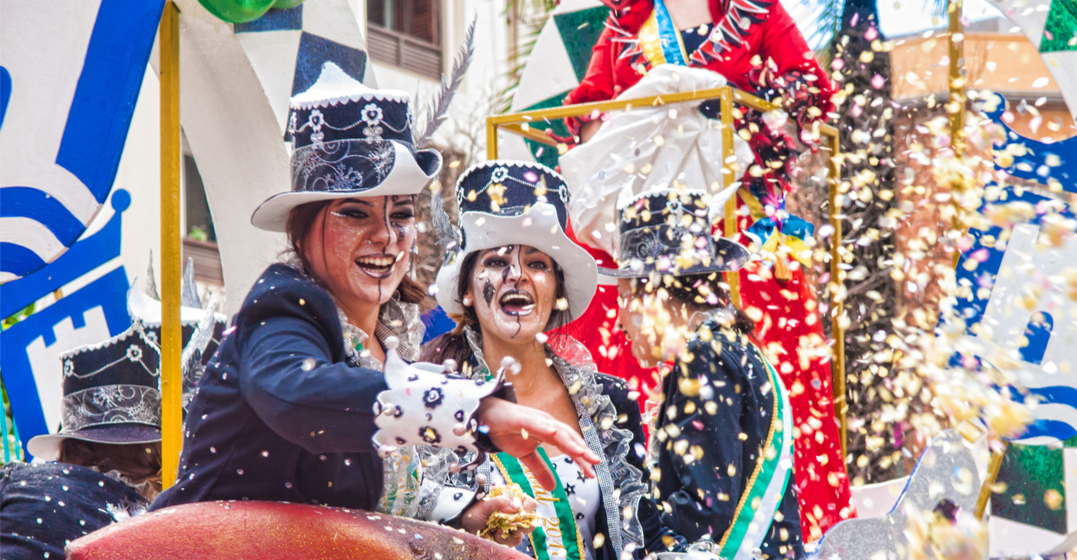by Lingoda Team
Updated on November 8, 2022
Carnival is a festive season recognized by Christians in many countries around the world, which occurs during the pre-Lent period in February or March known as Shrovetide.
Typically, carnival celebrations will include a parade or street party, complete with costumes and the consumption of food and alcohol.
Generally speaking, carnival season is associated with Catholicism. However, while many carnival celebrations around the world retain their religious links, others have grown into completely secular events; some of which occur at completely different times of the year and have themes that are not linked with the traditional carnival.
The history of carnival can be traced back beyond Christianity, to a time when the end of the winter would mark the final opportunity to eat plenty of food before the slaughtered livestock and other reserves would start to perish, leading to food shortages. Similarly, other groups celebrated the return to longer daylight hours.
By the Middle Ages, many had adopted carnival celebrations as part of Christian culture, serving as a celebration before Lent, which commemorates the New Testament story of Jesus fasting for 40 days in the desert.
Mardi Gras, which is French for ‘Fat Tuesday’, is celebrated on the day before Ash Wednesday and references the practice of eating fattier foods in preparation for the period of ritualistic fasting that lies ahead.
Although carnival celebrations occur in towns and cities across the globe, some of these celebrations are larger in scale and popularity than others.
Indeed, certain carnival celebrations play a key part in their country’s culture and attract overseas visitors looking to experience the sights and sounds.
In particular, the following six carnival celebrations hold special significance within their country and globally:
Officially the biggest carnival in the world, approximately 200 million people line the streets of Rio de Janeiro in Brazil on each of the four days.
Celebrations begin 40 days before Easter, music and dancing fill the streets, and the origins of this particular carnival can be traced all the way back to the early 1700s.
The parades include performances from hundreds of samba schools and street bands and feature floats and colorful costumes.
One of the most unique aspects of the Rio Carnival is the Sambadrome, a purpose-built parade area flanked by grandstands, where samba schools parade in direct competition with one another.
Kicking off on the Friday before Ash Wednesday, the Carnival of Santa Cruz de Tenerife is generally viewed as the second-most popular carnival celebration in the world.
It begins with an opening parade, with dancing and singing continuing on into the early hours of the morning and continues every day until Ash Wednesday.
The carnival is broadly divided into two unique aspects: the carnival on the street, which is a more loosely-organized affair, with street parties, dancing and singing, and the official carnival, which includes hundreds of musical groups.
The Saturday is dedicated to dance, the Monday is dedicated to feasting, the closing parade occurs on a Tuesday and a final ceremony, known as ‘the burial of the sardine’, is held on Ash Wednesday.
The Carnaval de Nice, or Nice Carnival, has a legitimate claim to being the oldest existing carnival celebration in the world, with its roots dating back to 1294.
Today, it attracts more than a million people to Nice, on the French Riviera, for 15 days worth of events, usually beginning in mid-February.
Each year a different ‘theme’ is chosen and celebrations revolve around that theme. Parades take place throughout the day and night, feature thousands of dancers and musicians from around the world and flowers feature heavily. In fact, one of the key selling points of this carnival is the ‘flower battles’ that take place.
Again, the Cologne Carnival, or Kölner Karneval, draws in excess of a million people to the city every year, making it one of the world’s most significant carnival celebrations. It takes place in the week leading up to Shrove Tuesday and features a number of fancy dress parades throughout the city.
In this German tradition, the main parade day takes place on the Monday before Ash Wednesday and is known as Rosenmontag (‘Rose Monday’), while the Tuesday sees more informal celebrations take place in the suburbs.
Celebrations include singing, dancing and drinking, while parades are led by the Dreigestirn; three people dressed as a prince, farmer and virgin.
Despite its name, the Notting Hill Carnival is an example of a secular carnival celebration, which is not linked to the Christian carnival season. Nevertheless, it attracts around a million people to London, confirming its place as one of the world’s most important street festivals.
It has been held since 1966 and there are two main days of parades; one for children and one for adults. The celebrations are led by members of Britain’s West Indian community, revolve heavily around reggae and other Caribbean music genres and somewhere in the region of 50,000 people perform at the event each year.
Finally, Mardi Gras is celebrated in New Orleans, Louisiana throughout the two weeks preceding Ash Wednesday, with at least one large parade each day, although the most grandiose celebrations are saved for the last five days. The origins date back to 1699 when the concept was introduced by French settlers.
Parades are organized by what are known as krewes, which are essentially social clubs and those riding on the floats will throw objects like beads or coins with a ‘krewe’ logo on them into the crowds that line the streets. Other events that take place during Mardi Gras include masquerade balls, street parties and musical performances.
